Fluffy, friendly, and full of sassy personality, both Pomeranians and chihuahuas are some of the most beloved small dog breeds in the United States. Both known for their charming personalities and cuddly natures, these dogs start out as tiny puppies and grow up to be, well, tiny dogs. Each has its own unique traits and quirks and many reasons to love them. But what are the real differences and what makes one more suitable for you than another?
Let’s take a look at the unique differences between the breeds and see why some folks choose one tiny dog to bring home over the other.
| Pomeranian | Chihuahua | |
|---|---|---|
| Origin | Poland and eastern Germany | Mexico |
| Height | 6 to 7 inches | 5 to 8 inches |
| Weight | 3 to 7 pounds | 3 to 6 pounds |
| Coloration | Single, bi-color, tri-color in orange, white, tan, merle, with merle, brindle, or sable patterns possible | Smooth, long, or short coats in single or bi-color; black, chocolate, red, fawn, cream, blue, gold, silver, white, chocolate blue, or tan coloring. |
| Grooming needs | daily grooming | Needs light to daily grooming, depending on hair length |
| Temperament | Energetic, friendly | Friendly and bright |
| Behavior and energy levels | Energetic but suited to small spaces | Energetic but suited to small spaces |
| Exercise needs | Two 15-minute walks daily, plenty of indoor games and interactive toys | 2 or more shorts walks daily, interactive playtime |
| Training | Fairly easy to train but not likely will never be fully disciplined | Intelligent and easy to train; requires challenge; will never be fully obedient |
| Lifespan | 12 to 16 years | 14 to 16 years |
| Health concerns | Generally healthy, but may experience ear infections, black skin disease, hypothyroidism, seizures, eye disease, heart problems, patellar luxation, hip or elbow dysplasia | Generally healthy, but may experience seizures, eye disease, heart problems, dislocated kneecaps, collapsed trachea, oral health issues, obesity, eye injuries, hypoglycemia, kidney stones, Necrotizing meningoencephalitis |
The Key Differences Between a Pomeranian and a Chihuahua
These two tiny dogs have a lot in common on a base level, but the differences between them can make all the difference in their suitability for your family.
Pomeranian vs. Chihuahua: Ancestry and Breeding
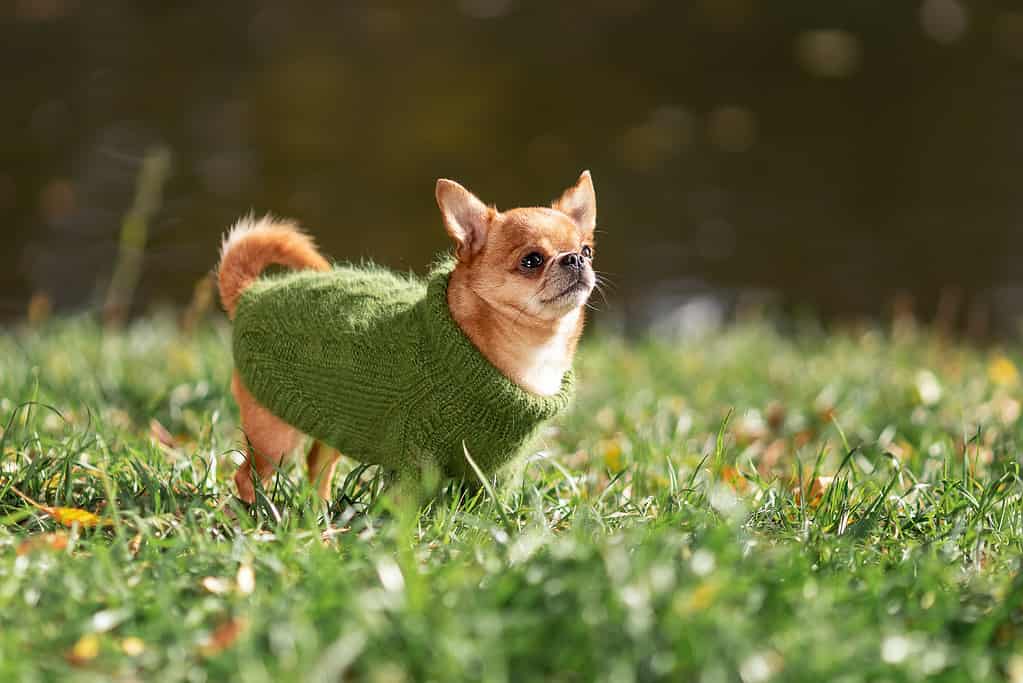
Chihuahua
dogs are originally from Chihuahua, Mexico.
©iStock.com/Irina Nedikova
Formerly known as Pomerania, the region of Poland and eastern Germany, brought us the Pomeranian dog breed. These pooches were bred as smaller versions of the German Spitz breed. Their fox-like faces; erect, triangular-shaped ears; pluming tail; and heavy coat make the small breed exceptionally popular. Interestingly, the tiny breed developed first as a favored dog for royals and nobles. Some famous folks who had Pomeranians include Isaac Newton, Michelangelo, and Mozart. They came to the U.S. and now are ranked as the 23rd most popular dog breed in the country.
Originally from Chihuahua, Mexico, the dog named for its origins has become an extremely popular dog breed in the United States. It originated from a breed thousands of years old, known as the Techichi. The breeding history of this tiny dog now called the Chihuahua, is a bit of a mystery. We do know that the Aztec people overthrew the Toltecs, the people who bred these tiny dogs. The little dog vanished when the Spanish invaded. During the 19th Century, the breed was brought northward into the United States where it became one of the most popular dog breeds of all time. They currently rank as 33rd most popular in the U.S., falling 10 places behind the Pomeranian.
Pomeranian vs. Chihuahua: Size and Appearance
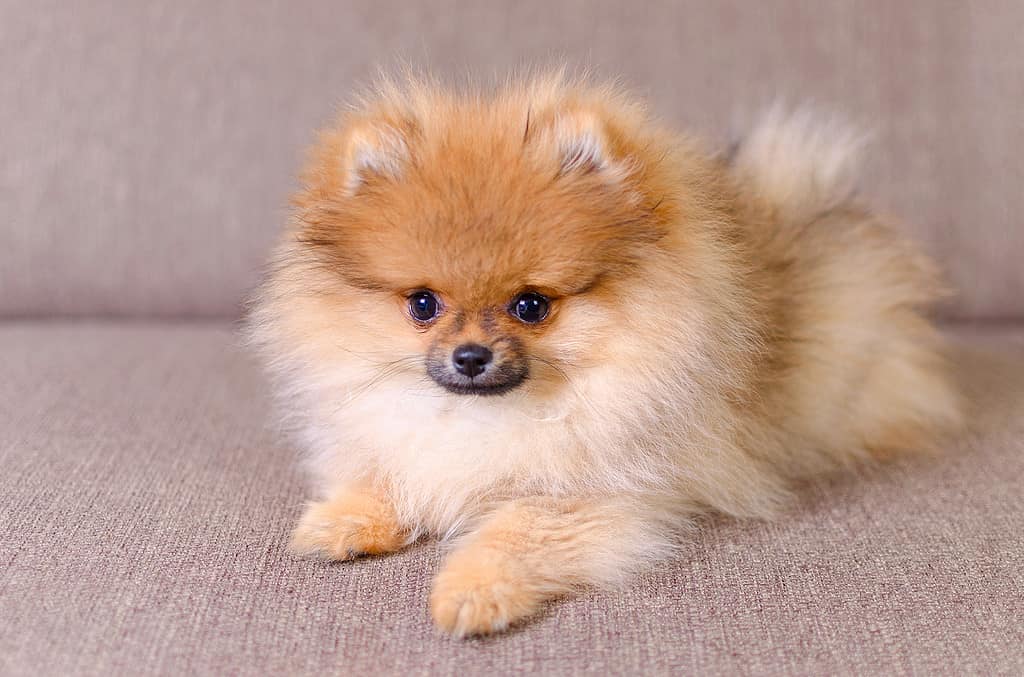
Pomeranians originated from Poland and eastern Germany.
©iStock.com/nadisja
While the most well-known color of the Pomeranian coat is orange, these tiny little dogs actually come in black, brown, blue, red, cream, or white. They might be in single or bi-color, or even tri-color coat combinations. Sable, merle, or brindle patterns may show up, with markings of white, tan, or merle possible. Weighing in at between 3 and 7 pounds, the little fox-faced dogs may reach heights between 6 and 7 inches in height.
Just a hint smaller, coming in between 5 and 8 inches tall and between 3 and 6 pounds, chihuahuas also come in a range of colors. Their coats might be rough or smooth, long or short, with single or bi-color options. Black, chocolate, red, fawn, cream, blue, gold, silver, white, chocolate blue, and tan are among the most common colors of chihuahua coats. They have large, upright ears and either domed apple or flatter deer head shapes.
Pomeranian vs. Chihuahua: Grooming
Of the two breeds, Pomeranians are more likely to need more grooming than chihuahuas. Short-haired chihuahuas generally just need a brush-through every week or so. Those with long coats will need brushing through several times a week. Frequent grooming of both dogs will help remove dirt and keep their fur tangle-free. Even still, Pomeranians usually need daily grooming because their hair is thicker than long-haired chihuahuas.
Both dog breeds have double coats and both shed, particularly during shedding season. Chihuahuas are lower shedders than poms and some larger dog breeds, but they do still shed and neither is hypoallergenic.
Pomeranian vs. Chihuahua: Temperament
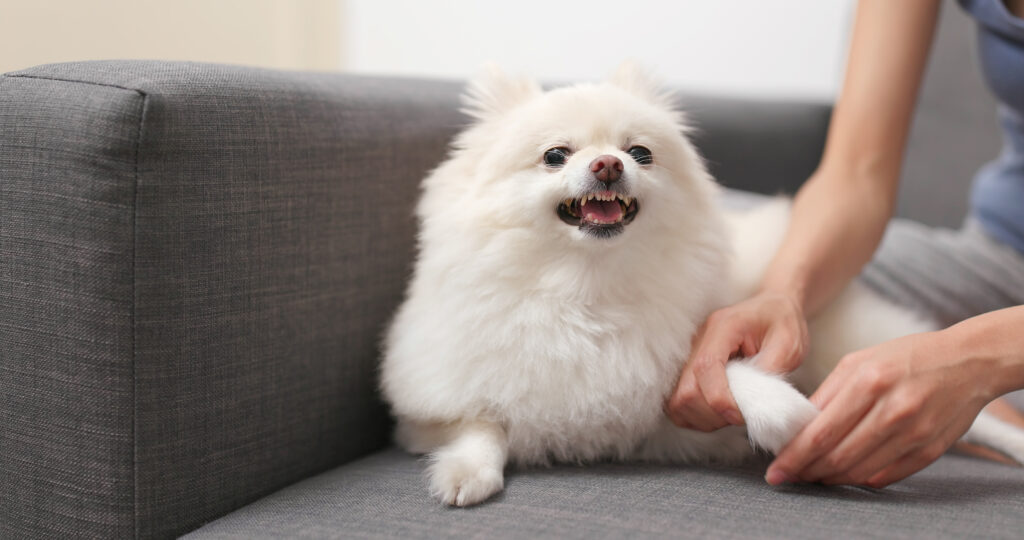
Pomeranian dogs like other breeds can have paw sensitivity.
©leungchopan/Shutterstock.com
Pomeranians and chihuahuas have bold, energetic personalities. They’re generally unafraid of pretty much anything, which helps to make them both highly sociable and attention-seeking. They’re exceptionally good companion animals, looking for loads of affection and attention. They are known to suffer from separation anxiety, however, so if you’re looking for a dog that’s independent, you’re barking up the wrong tree.
Pomeranians are thought to bark more than chihuahuas, particularly when they’re young or when they’re dealing with anxiety. Of the two, chihuahuas are more likely to be suited to areas with noise restrictions.
The two breeds are tough little critters, but they’re also delicate and don’t do great with very young children in most cases. They tend to get injured when handled by small children. Once the kids are older and able to know how to treat animals well, the little breeds are well-suited to children, thanks to their high energy and friendly personalities.
Chihuahuas are exceptionally bright and eager dogs and need firm, consistent training. Otherwise, they’ll show signs of dominance and aggression towards other dogs and people they don’t like. Training comes naturally for both breeds, though, thankfully.
Pomeranian vs. Chihuahua: Behavior and Energy Levels
Both dogs are small enough that they don’t require large amounts of space. However, they will definitely “use up” every inch they’re given. But having people to play with pleases both breeds enough that they typically don’t even need more room than a studio apartment can provide them. Because they love people and socialization, the dogs enjoy traveling with their companion humans and spending time in both outdoor and indoor settings with other humans and sometimes other dogs.
Pomeranian vs. Chihuahua: Exercise Needs
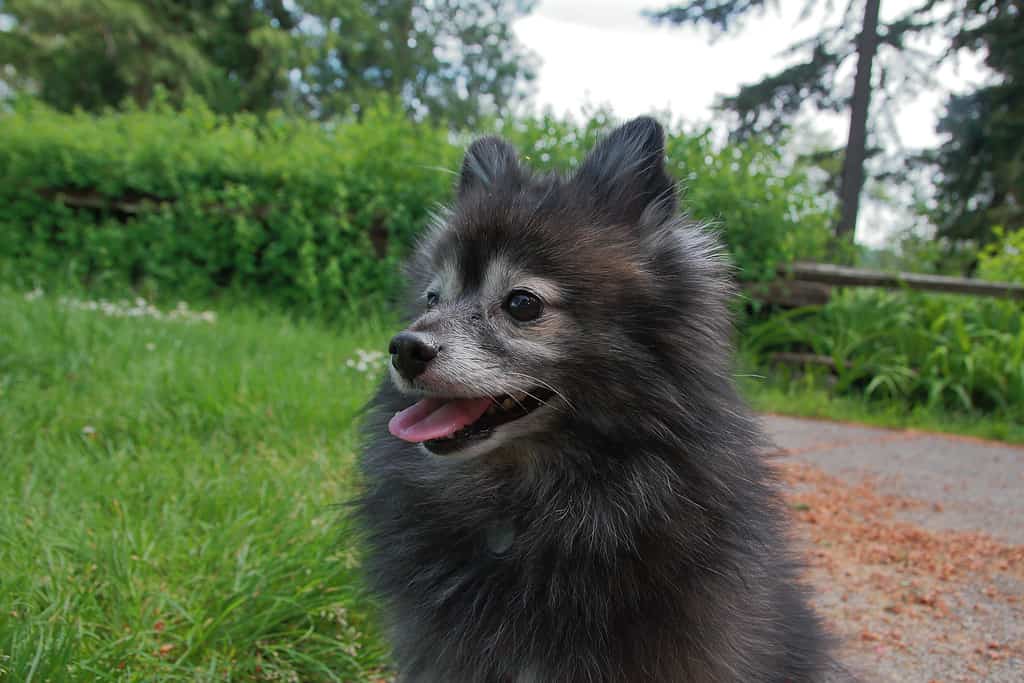
A
papillon
mix can include a Paperanian, or a cross between a Pomeranian and a papillon.
©casualphotographerpdx/Shutterstock.com
In some cases, size matters. The tiny size of Pomeranians and chihuahuas means they need less time exercising. In both cases, about 30 minutes of exercise daily is the standard minimum requirement. They’re both considered medium-energy dogs (though they may seem high-energy due to their size!). They are generally seen as the most energetic breeds in the toy group. They are lap dogs, certainly, but they need plenty of time to play, even if they’re playing by themselves.
Their size also means they don’t need large backyards or long walks. Taking them out for two 15-minute walks usually suffices. They can thrive in almost any climate, as long as they have protection for their paws in cold environments. Provide them with interactive games and puzzle toys for the rest of the day. And if you have an area where you don’t want them playing, be sure to block it off. They’re both known for getting into trouble and causing messes when they get bored.
Their size also means that neither breed has a lot of endurance. Don’t expect to take these little guys for long jogs or extended walks. Instead, plan on two or more short walks and lots of indoor bursts of playtime. It should be noted that chihuahuas are prone to obesity. If you notice your little pooch chunking up, you might need to increase those short walks by a couple of minutes or add in another short walk or two each day.
Pomeranian vs. Chihuahua: Training
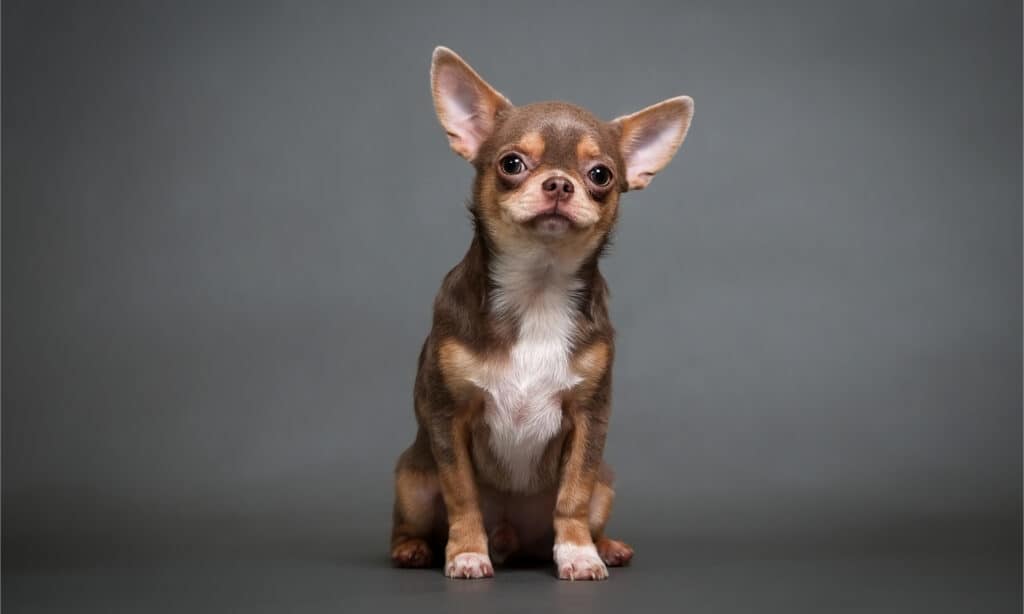
Chihuahuas don’t shed like some other more popular breeds!
©Al_Er/Shutterstock.com
Both known for being independent and stubborn, chihuahuas and Pomeranians require effective training to help them do well with children and other animals. They’re both fairly trainable, however, which means this is fairly easy to do. Obedience won’t be their natural state. Some days they simply won’t be “in the mood” to obey, but once they learn their commands most of the time they’re fairly compliant. Strict situations aren’t going to be great for them, though, as their stubborn natures will come out in rebellious forms.
Consistent, positive reinforcement is the way to go with training for both breeds. Starting earlier in their lives, when they’re young pups, is also important, at least if you want a well-behaved dog. Socialization early also means they will do far better in group settings with other dogs or humans. They may become territorial over their humans and bark a lot if they’re not socialized properly.
Both breeds are incredibly intelligent, as well, so they will enjoy being challenged in their training sessions. Short sessions between 10 and 15 minutes are ideal, allowing them to learn and grow while maintaining their attention. Keep sessions daily for the best results.
Pomeranian vs. Chihuahua: Lifespan
Smaller dog breeds often have longer lifespans than their larger counterparts. Chihuahuas typically live between 14 and 16 years of healthy life. Pomeranians are more likely to live between 12 and 16 years. Both breeds enjoy good health generally, but their backgrounds vary somewhat on what signs you should look for.
Pomeranian vs. Chihuahua: Health Concerns

There are many reasons dogs chew their paws, from anxiety and boredom to health issues
©kamilpetran/Shutterstock.com
Proper care for both poms and chihuahuas will likely help improve the life of your dog and expand their years. But genetics, accidents, and other unexpected issues may arise.
Both breeds have small mouths and therefore may deal with crowded teeth, resulting in dental and oral issues. Collapsed trachea is common for both dogs, as well as accidental poisoning and patellar luxation (dislocated kneecaps). Seizures, eye disease, and heart problems also may plague either breed, as well as hydrocephaly, a dangerous condition of fluid present in the skull from birth. Fontanel (soft spots on the skull) may also be present and should be watched for.
Additionally, Pomeranians may develop:
- Ear infections
- Black skin disease (alopecia and skin hyperpigmentation)
- Hypothyroidism
- Leg-calve-Perthes (reduced blood flow to the hip)
- Hip and elbow dysplasia
Chihuahuas don’t have as many conditions, but they may deal with
- Birthing complications (due to their large heads)
- Eye injury (due to bulging eyes)
- Hypoglycemia
- Necrotizing meningoencephalitis (the swelling and death of brain tissue)
- Obesity
- Kidney stones
- Dental disease
Be sure to keep up vaccinations and regular health care checkups for either breed to help prevent or detect conditions early on.
The photo featured at the top of this post is ©
Ready to discover the top 10 cutest dog breeds in the entire world?
How about the fastest dogs, the largest dogs and those that are -- quite frankly -- just the kindest dogs on the planet? Each day, AZ Animals sends out lists just like this to our thousands of email subscribers. And the best part? It's FREE. Join today by entering your email below.
Thank you for reading! Have some feedback for us? Contact the AZ Animals editorial team.







